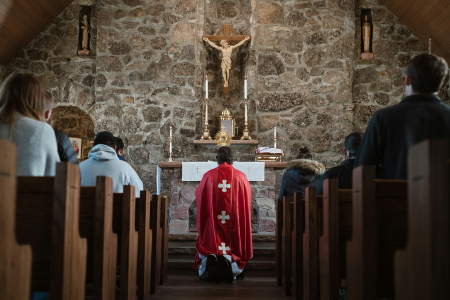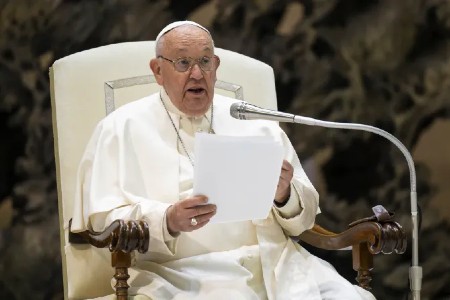 Hi readers, it seems you use Catholic Online a lot; that's great! It's a little awkward to ask, but we need your help. If you have already donated, we sincerely thank you. We're not salespeople, but we depend on donations averaging $14.76 and fewer than 1% of readers give. If you donate just $5.00, the price of your coffee, Catholic Online School could keep thriving. Thank you. Help Now >
Hi readers, it seems you use Catholic Online a lot; that's great! It's a little awkward to ask, but we need your help. If you have already donated, we sincerely thank you. We're not salespeople, but we depend on donations averaging $14.76 and fewer than 1% of readers give. If you donate just $5.00, the price of your coffee, Catholic Online School could keep thriving. Thank you. Help Now >
Jíbaro Indians
FREE Catholic Classes
Jíbaro (Spanish orthography) "forest man", i.e. native.
An important tribal group of Ecuador, comprising a great number of small subtribes speaking a common language with dialectic variants, and together constituting a distinct linguistic stock, holding the extensive forests between the Santiago and Pastaza rivers and southward to the Amazon. Owing to similarity of name — also written Xebaro, Zibaro — they have been frequently confounded with their eastern neighbours, the Zaparo, and the confusion is increased by the fact that in earlier times the name Jíbaro was often loosely used to designate any of the wild Indians of eastern Ecuador. More than any other tribe of the upper Amazon region, the Jíbaro are notable for their determined and successful resistance to all efforts at conquest or Christianization, and notwithstanding more than three centuries of more or less intimate Spanish contact they still retain their primitive manners to a remarkable degree. They have no villages, the houses of each small community being scattered about in the forest within easy communicating distance, and always close to a stream. The houses are communal, from fifty to eighty feet in length, with a door at each end, one exclusively for the men and the other for the women. Near the women's door are the fire-places for cooking, one for each family, while outside the men's door is the tunduli , or great wooden drum, made from a hollow log, the sound of which can be heard for a distance of ten miles through the forest, and by means of which, according to a well-understood code, the Jíbaro can signal to his farthest acquaintance.
War is their normal condition, the favourite weapons being the lance, the javelin with throwing stick, the blow-gun with poisoned arrows, and the shield for defence. The heads of enemies are smoked by an ingenious process which in a measure preserves the features. The women are expert potters. The Jíbaro are agricultural, cultivating corn, beans, bananas, yuca, and cotton. Besides dogs, parrots, and monkeys, they have chickens and hogs, which were introduced among them by the whites. They use no salt, but like many other tribes of the Amazon and Orinoco are addicted to eating a certain saltpetrous clay. Their favourite drink is chicha , a mild intoxicant fermented from the yuca, banana or some other native plant. They wear a cotton dress below the waist, flowing hair, paint, feather ornaments, ear pendants, and — among women — labrets. They are robust and comparatively handsome, although not tall. They are very fond of music, visiting, and ceremonial dances. Polygamy exists, as also, according to some travellers, the curious custom of the couvade . The dead are usually laid away in small shelter structures in the woods or in hollow tree-trunks placed in the house where the death occurs, the house being then abandoned. There is apparently no tribal organization or chiefly authority, the only bond among families being their habitual attendance at common festivals. In each family group one man has the duty of reciting a long historical and didactic discourse each morning while the women are preparing breakfast. Very little is known of their religious or mythologic beliefs, but witchcraft flourishes, and almost every death is attributed to this cause.
Sheltered by their forests, the Jíbaro successfully withstood the efforts of the Peruvian Incas to subjugate them. The first Spanish entrance into their country was made by Vergara in 1541, and in 1559, under order from Governor Salinas, five towns were established in the Jíbaro country, first and chief of which was Logrono. Under enforced labour in the mines, and other oppressions, at the hands of their Spanish taskmasters, the Indians rapidly withered away or saved themselves by retreating deeper into the forests. In 1599 a fresh tribute goaded the Jíbaro into rebellion, and under the leadership of Anirula a force estimated by many at 20,000 warriors stormed Logrono in a night attack, killing every inhabitant to the number of 12,000, excepting the young women, and burning the city to the ground. The governor was killed by pouring molten gold down his throat "in order that he might have his fill of gold". The inhabitants of the other towns took refuge in Sevilla del Oro, which was next attacked, but resisted so stoutly that the Indians finally retired after having killed nearly 14,000 of the besieged. The young women were carried off as wives to the savages, and it is said that the admixture of blood is still evident in the clearer skin and more abundant beard of many of the tribe. Successive expeditions failed to reduce the Jíbaro, until it was resolved to call in the help of the missionaries. In 1645 two Franciscan fathers, Laureano de la Cruz and Andrés Fernández, with a small military escort, entered the territory from the west, and in 1656 Commander Agureo with a detachment of troops and a company of mission Indians under the Jesuit Father Raimundo Santa Cruz, attempted a settlement at the mouth of the Pastaza, but the attempt was a failure through the bad conduct of the soldiers. Other unsuccessful missionary attempts were made in 1690, and in 1692 a combined force of Spanish troops and mission Indians, the latter under the superior of the Jesuit missions, Father Viva, began a series of manhunts in the Jíbaro country, but with so little result that in five months only three hundred and seventy-two Indians were captured, most of whom escaped later. In these raids the Indian mothers frequently slew their children with their own hands to prevent their falling into the hands of the Spaniards.
 Hi readers, it seems you use Catholic Online a lot; that's great! It's a little awkward to ask, but we need your help. If you have already donated, we sincerely thank you. We're not salespeople, but we depend on donations averaging $14.76 and fewer than 1% of readers give. If you donate just $5.00, the price of your coffee, Catholic Online School could keep thriving. Thank you. Help Now >
Hi readers, it seems you use Catholic Online a lot; that's great! It's a little awkward to ask, but we need your help. If you have already donated, we sincerely thank you. We're not salespeople, but we depend on donations averaging $14.76 and fewer than 1% of readers give. If you donate just $5.00, the price of your coffee, Catholic Online School could keep thriving. Thank you. Help Now >
In 1767 the Jesuit Father Andrés Camacho made another effort, with some fair promise of success, when the decree of expulsion banished the Jesuits from their missions, which were then turned over to Franciscans and secular priests and speedily fell into decay. This may be considered the end of any systematic attempt at Christianizing the Jíbaro. As far back as 1581 the Dominicans of Quito had undertaken a similar work at Camelos on the Pindo, but after more than two centuries the only result was three small villages containing two hundred and forty baptized Indians, and about half that number in 1814. Several Franciscans also entered the territory from time to time, notably Father Antonio Prieto in 1816, who discovered some important pre-Columbian ruins. In 1869, the restored Jesuits began work again at three stations, but were driven out a few years later by an Indian rising. In 1886 the Dominicans and in 1893 the Franciscans re-entered the field and have now mission stations at Macas (D) Canelos (D) and Zamora (F), while the Jesuits are at work on the Napo. In 1893 the Salesians were authorized to enter the territory, which had been newly erected into the Vicariate Apostolic of Mendez and Gualaquiza. Intestine feuds, smallpox visitations, alcohol, and other causes have steadily reduced the number of the Jíbaro until, for the 20,000 warriors who sacked Logrono three centuries ago, the whole nation today does not count more than as many souls, and experienced missionaries think they do not exceed 10,000 or 12,000 of whom only about 1400 are rated as Christians.
We ask you, humbly: don't scroll away.
Hi readers, it seems you use Catholic Online a lot; that's great! It's a little awkward to ask, but we need your help. If you have already donated, we sincerely thank you. We're not salespeople, but we depend on donations averaging $14.76 and fewer than 1% of readers give. If you donate just $5.00, the price of your coffee, Catholic Online School could keep thriving. Thank you.Help Now >
Join the Movement
When you sign up below, you don't just join an email list - you're joining an entire movement for Free world class Catholic education.
-

-
Mysteries of the Rosary
-
St. Faustina Kowalska
-
Litany of the Blessed Virgin Mary
-
Saint of the Day for Wednesday, Oct 4th, 2023
-
Popular Saints
-
St. Francis of Assisi
-
Bible
-
Female / Women Saints
-
7 Morning Prayers you need to get your day started with God
-
Litany of the Blessed Virgin Mary
U.S. Catholic Parishes Experience Resurgence of Traditional Practices
-

Pope Francis Urges Faith and Prayers for Peace
-

Florida Welcomes Volunteer Chaplains to Public Schools
-
10 Fascinating Details About St. Joseph the Worker: Celebrating His Feast Day - May 1
-
St. Joseph the Worker: Model for Men, Young and Old
Daily Catholic
 Daily Readings for Thursday, May 02, 2024
Daily Readings for Thursday, May 02, 2024 St. Athanasius: Saint of the Day for Thursday, May 02, 2024
St. Athanasius: Saint of the Day for Thursday, May 02, 2024 The Our Father: Prayer of the Day for Thursday, May 02, 2024
The Our Father: Prayer of the Day for Thursday, May 02, 2024- Daily Readings for Wednesday, May 01, 2024
- St. Marculf: Saint of the Day for Wednesday, May 01, 2024
- To Saint Peregrine: Prayer of the Day for Wednesday, May 01, 2024
We ask you, humbly: don't scroll away.
Hi readers, it seems you use Catholic Online a lot; that's great! It's a little awkward to ask, but we need your help. If you have already donated, we sincerely thank you. We're not salespeople, but we depend on donations averaging $14.76 and fewer than 1% of readers give. If you donate just $5.00, the price of your coffee, Catholic Online School could keep thriving. Thank you.Help Now >
![]()
Copyright 2024 Catholic Online. All materials contained on this site, whether written, audible or visual are the exclusive property of Catholic Online and are protected under U.S. and International copyright laws, © Copyright 2024 Catholic Online. Any unauthorized use, without prior written consent of Catholic Online is strictly forbidden and prohibited.
Catholic Online is a Project of Your Catholic Voice Foundation, a Not-for-Profit Corporation. Your Catholic Voice Foundation has been granted a recognition of tax exemption under Section 501(c)(3) of the Internal Revenue Code. Federal Tax Identification Number: 81-0596847. Your gift is tax-deductible as allowed by law.








 Daily Readings for Thursday, May 02, 2024
Daily Readings for Thursday, May 02, 2024 St. Athanasius: Saint of the Day for Thursday, May 02, 2024
St. Athanasius: Saint of the Day for Thursday, May 02, 2024 The Our Father: Prayer of the Day for Thursday, May 02, 2024
The Our Father: Prayer of the Day for Thursday, May 02, 2024
